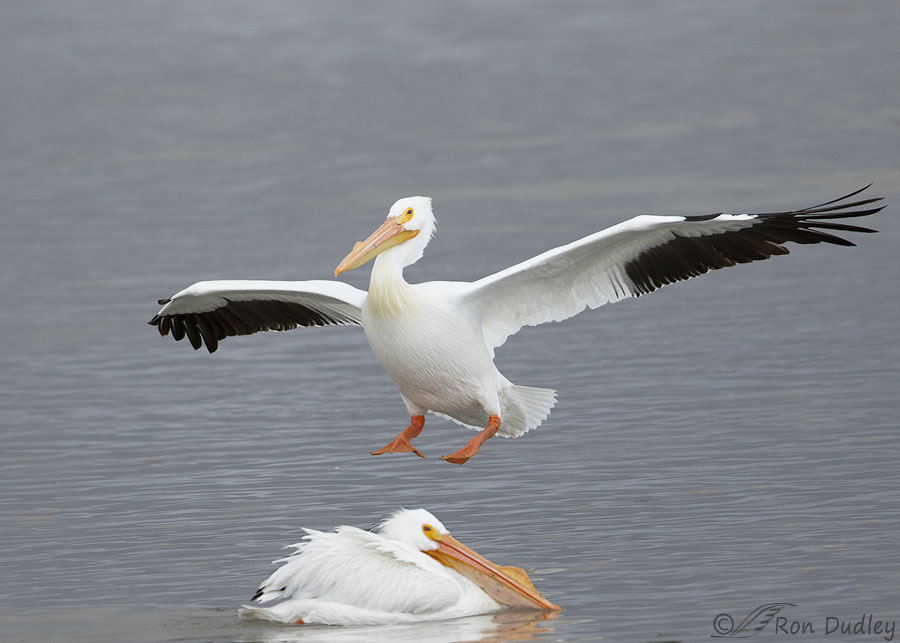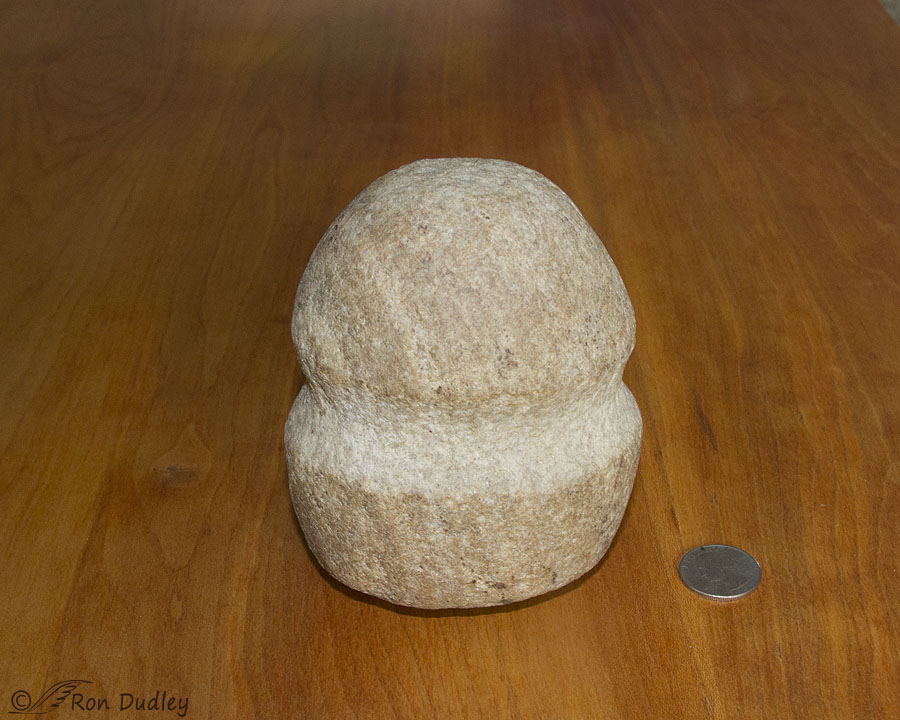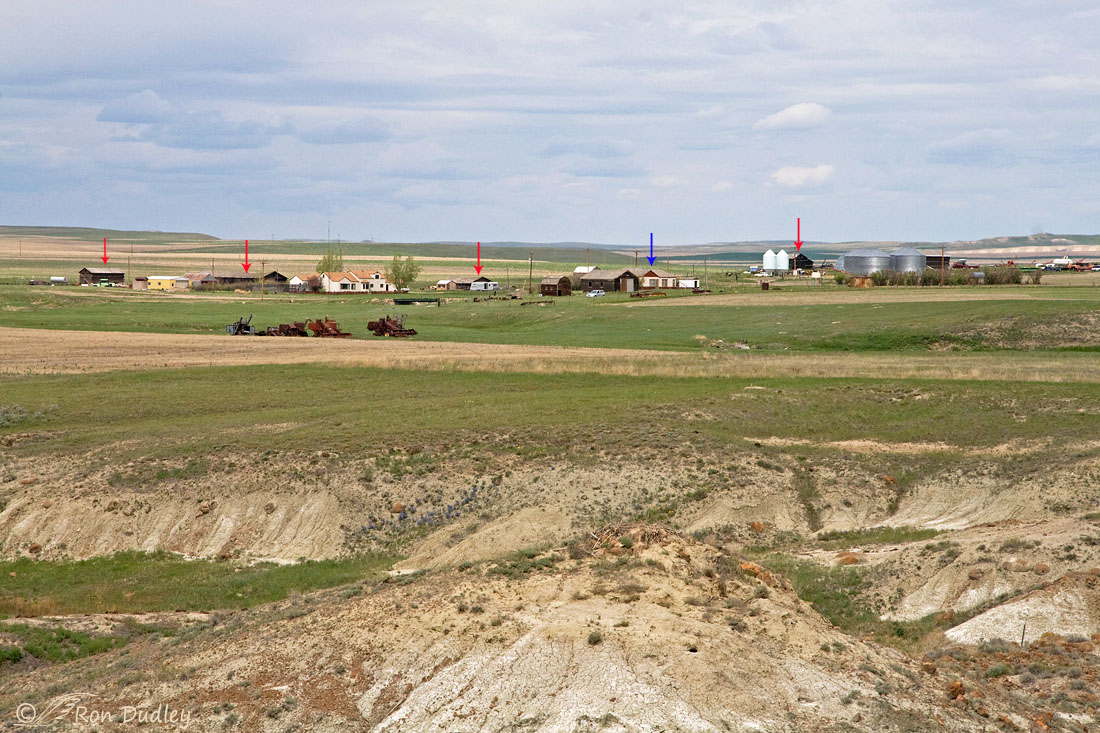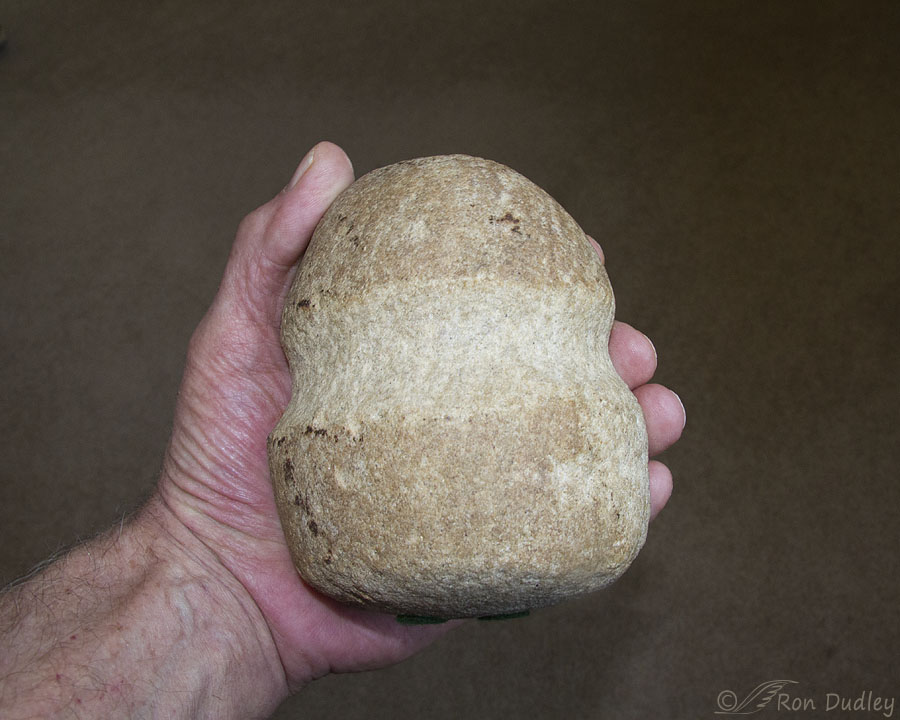Plus why I’m so enamored by the traditions and artifacts of the Plains Indians and their connections to our family farm (yes, I got a little carried away today…).

1/1600, f/6.3, ISO 640, Canon 7D Mark II, Canon EF 500mm f/4L IS II USM + EF 1.4 III Extender, not baited, set up or called in
I took this photo on February 28, 2017 as the pelican in flight was coming in for a landing at Bear River MBR.
I enjoy the relative positions of the two birds because it almost appears as if the bird in flight is about to take the head off of the swimming one, or at least skim its back with its feet. It didn’t of course but it reminds this old Montana farm boy of the Plains Indian tradition of counting coup – striking an enemy and surviving the encounter. As a kid I was steeped in many of those traditions, partly because of the nearby Blackfeet Indian Reservation and because some of my good friends were tribe members.
We’d occasionally find arrowheads on the farm and there were old teepee rings there too. My family sold our farm to my uncle Floyd Dudley in the late 60’s but his son, my cousin and best friend Ken Dudley, lived and farmed there for the rest of his life and one of his favorite things to do while walking the fields was to search for Indian artifacts.

One of his prized possessions was this hammer stone he found on the farm years after my family and I left. It could have been left by the early Blackfeet or perhaps it’s far more ancient than that – no one knows. That land had been farmed by my family for over 75 years so any context giving clues about its origin, if they ever existed, have been lost.
When Ken died in 2007 his siblings asked me what I would like of his as a remembrance. Ken had lots of “stuff” but I immediately knew what I wanted most of all – the hammer stone. I keep it in a place of honor in my living room but it’s my intention to return it to the approximate area of the farm where it was found on my next trip up there. I think that’s where it belongs.
Here I have it in my hand to give a better idea of its actual size. The dark green discs at the bottom are felt pads to protect my furniture. That thing is heavy!

Another part of the allure for me of growing up on the farm was finding fossil dinosaur bones. In this expansive view of the home operations of the two adjoining Dudley farms taken about 10 years ago we see a small portion of the “badlands” area of our land that was heavily eroded by a small creek (most of our actual farmland, about 3000 combined acres, is out of frame behind me and to the right). As kids we called this area the Crystal Hills and the name stuck because some pretty impressive quartz crystals were common there. But as we grew older we also discovered that fragmented dinosaur bones could be found in these eroding slopes and we spent endless hours looking for and finding them. Crystals and dinosaur bones – great fun for a kid and even for the kid in me as an adult, even though I never kept any of the bone fragments.
The following will probably bore some readers to tears but for long-time followers of Feathered Photography I’m sure some of the references will be familiar and hold interest:
- A large raptor nest can be seen on top of the cone-shaped hill in the foreground. I believe it was a Ferruginous Hawk nest but it wasn’t being used when I took the photo.
- Over the years I’ve posted many images of the resident Great Horned Owls on the farm. Most of them were taken as the owls were roosting in or on the many abandoned granaries and barns I’ve marked here with red arrows. There’s a 5th old granary out of sight behind the larger house.
- The older house marked with the blue arrow is the one my father built and the one I grew up in. Sadly that house is gone now. As you can see the beginning of the Crystal Hills was only a short distance from our house and I spent endless hours exploring them, on foot and on my horse Star – they follow the creek for quite a distance that we can’t see here.
- My cousin Ken Dudley owned and operated the combined farms for many years and their house is the larger one to the left. Most of the entire spread remains in the family today.
- Glacier National Park is just out of view over the horizon to the left. From a different angle we can easily see the iconic Chief Mountain and many other mountains in the park.
I could go on but it’s probably past time to quit. But with this post you can see how my posts sometimes expand in unexpected directions. My original intention was to include only a single photo – the one of the pelicans. But as I studied that image and almost immediately thought of “counting coup”, the hammer stone came to mind and then the Crystal Hills and this view of the farm.
In the end I just let it flow and went with it.
Ron



I really enjoyed this post. For one thing, we have white pelicans here on the upper Texas coast in the winter, and it’s always a joy to see them, and to see good photos of them. Beyond that, I used to spend a lot of time at a cabin on a few acres up in the Texas hill country. It was relatively isolated — no electricity, water pumped up to a barrel from a spring, and so on — but it had a substantial Indian cooking mound alongside the creek. We never dug for artifacts, but after every heavy rain, another layer of soil would be sluiced off, and we often found arrowheads, scrapers, and such. There were fossils galore in the old Cretaceous limestone cliffs, too: especially clams and other shells.
Your hammer stone reminds me of the chert nodules we’d find up there. They often were split, providing material for the arrowheads and such, but the ones that were whole were about the same size as the hammer stone. I’ve a few of the chert nodules and fossils, but we never collected the tools, or told anyone about the mound. It makes perfect sense to take the hammer stone back to its home.
Shoreacres, as you obviously know, chert was a very common material for native American tools, including but not limited to arrowheads. I once watched a skilled flintknapper making arrow and spear heads for several hours and even tried my hand at it. About all I got was sliced up and bloody fingers. That stuff is SHARP when it flakes off.
Good for you for keeping quiet about that mound you found. If you hadn’t it would, without a doubt, be looted and destroyed by now.
I love learning more about you. Keep sharing!
Thanks, Deedee. I thought I told you all of my deep, dark secrets on those museum trips years ago… 🙂
You need to stop writing such engrossing stories. I think you were counting coup (in a friendly way) by touching on so many subjects and reminiscences, all because of a couple of pelicans. I kept coming back to see everyone’s comments and your responses. Your really took a chunk out of my day, albeit an enjoyable chunk😉
Your comment made me more than smile, Lyle – it made me laugh out loud.
Yeah, I did jump around a bit, didn’t I. Thanks very much for an enjoyable comment.
A lovely reminiscence by you and lively commentary from your readers, really enjoyable. Thanks for the post. But why Pelicans decided to show up regularly in a place they had not been throughout your youth is especially odd. Wonder what happened there? 😳
I’ve often wondered about that, Chris. Same thing happened with gulls. When I was a kid and young teenager we never saw gulls anywhere near the farm. Then they were suddenly common, often following the tractor I was driving and feeding on insects stirred up by the plow.
Nothing like special memories. I have always been a country girl at heart, even those I was raise in the suburbs, so I find your family history interesting. It’s nice you can get back to your old stomping grounds now and then. Our dream is to move to Montana. Beautiful area!
There’s a Montana price to pay, Jean. Extremely cold in the winter and lots of wind, especially east of the mtns. Worth it though, mostly… 🙂
You can go off on Montana farm tangents as often as you want!!! I love hearing those stories. Thank you for the overview shot too. I can now put buildings in perspective, sort of like putting a face to a name. I am EXTREMELY jealous of your paleontological backyard. I keep telling myself that “one of these days” I’ll get out there. I volunteered at the La Brea Tar Pits when there was a dig back in the late 80s (How in the hell did I get tar there?!), but never out in dinosaur country. Sigh…
Thanks, Marty. I remember reading about the La Brea Tar pits when I was a young kid. I was absolutely fascinated!
Thanks for these great personal northwest Montana memories. Mine are all second hand but just as fond. My mother grew up in Shelby. As a nineteen year old she met and married my Dad who came in to town with the construction company that re-built the grain elevator southeast of town. She and Dad spent their honeymoon in a motel just down the street from her family home…and also heard there the live news reporting of the bombing of some place called Pearl Harbor. Dad actually knew where it was and knew exactly what was coming next. One of my aunts lived in Cut Bank for years. A California cousin decamped from her Left Coast home and has lived in Helena for longer than I recall. Growing up I’d heard a lot about your home territory but never went there until 1997 when my daughter and I took Mom to visit Shelby for Easter Break. We walked the town and recorded Mom as she led us around reminiscing about her time there. She walked us through the entire cemetery–twice–and had a story for almost every set of family stones. One afternoon we drove over to Conrad to visit Mom’s last living relative in that country; an aunt on whose family farm Mom had spent several summers She’d been to Glacier Park and for years had rhapsodized about that experience and about the Sweetgrass Hills jutting up on the northern horizon. When we asked her what it was like there she said: “I don’t know. I never went there.” We immediately got in the rental car and drove the 30 miles or so north on the four lane gravel road. She finally got to see them up close. She’d also always spoken fondly about many childhood trips to Great Falls to buy a new pair of shoes for the start of school. The night we drove back there to catch our flight home I asked: “What did you think of the falls in Great Falls?” Her reply: “There’s waterfalls in Great Falls?” Though it was well past all our bedtimes and staring down an early departure in the morning, we detoured over to the fabled Great Falls of the Missouri–the end of that legendary water highway into The West– and she got her first and last look…in a drizzling midnight rain. Better late than never Mom.
Another rich source of stories from and inspired by that region of Montana are the many novels of Ivan Doig. If you’ve not read them it’s not too late…as Mom proved more than once.
I enjoyed the hell out of your comment, James. It brought back so many memories of my own.
The sports rivalries between Cut Bank and Shelby were legendary. I actually spent part of a night in their local hoosegow as a teenager. Don’t ask…
I’ve never been actually on any of the Sweetgrass Hills and I still regret it – they were the last bastion of the migratory bison herds.
We often did our “big shopping” in Great Falls too – 125 miles away back then on a 2 lane road but it was shortened somewhat when they put in I-15.
I’m curious about who your aunt in Cut Bank was…
And yes, I have several of Doig’s books.
Thanks for taking the time to reminisce!
I really didn’t mean to run on so. I’m glad I didn’t put you entirely to sleep. We’d heard so much from Mom over the years about Shelby and the surrounding country that my daughter and I have always applauded our wisdom in actually going there with her to shepherd us about. It was a great trip and is a beautiful–if desolate–part of the country.
Aunt was Mary Jane (Houde) Hansen.
And here’s one more secondhand Montana memory:
When Dad was courting Mom his best friend on the construction crew was courting (and eventually married) her sister. During the double courtship–during the late fall of 1941–they doubled dated to a dance in Great Falls. Somewhere along the way there they hit a horse. The horse got the worst of it with the car mainly suffering only a broken windshield. My parents and my aunt and uncle loved telling the story of driving to and from Shelby late at night in November with no windshield. I never thought to ask how the need to stay warm–under those circumstances–may have served to advance the courtships.
Wonderful commentary! Amazing what we “don’t see” when we live in a place or have other priorities at the time…… 😉
This is an absolutely delightful post.
The pelicans (whose dinosaur ancestory is so evident) fit beautifully with the historical theme. And owls, a horse, arrow heads, crystals, native american friends AND dinosaur fossils? A childhood to fill memory banks to overflowing with riches.
Yup, you hit many of the high spots for me, EC. As always, you’re very insightful.
I always enjoy your reminiscences as much as your photos thank you for today’s chapter ! You do it so well I believe you have an interesting book in that noggin of yours .
You’d have loved it out there, Laurel. Book? – not a chance… 🙂
What a lovely post! You appear to have had the childhood I dreamed about when I was little. I was a tomboy and grew up in Massachusetts and read a lot about the West. I’d roam around looking for arrow heads and artifacts, wishing I had a pony!!
I was very lucky to have a horse, Joanne.
Star was an older thoroughbred and she was huge. She was given to me by an uncle of my mom’s in Alberta. As a kid my dad had watched as one of his friends was killed when his foot got caught in a stirrup while he was riding. Dad was so horrified by what he saw he never let me have a saddle so I always rode bareback. Star was so tall that I couldn’t even get on her unless there was a fence or something next to her. I fell off many a time far from any fence so I walked home with my tail between my legs more often than I can count. That experience teaches humility…
Ron, this is a great post, and I like to hear of your memories. This would be nice of you to return the stone to the original place.
That’s my plan, Trudy. At least to as close to the original place as possible. Ken only told me roughly where he found it.
Loved this. I’ll bet that hammer stone would make the tribal elders happy if they have a museum.
Thanks, Arwen. See my response to Ken Schneider below.
Wonderful story Ron, Thanks for sharing.
Len
Thank you, Len.
Ron – outstanding pelican photo – looks like he could land right on top of the other. What a great place to grow up and what a neat learning experience to grown up in such close proximity to Native Americans. Growing up back east the closest I came to Indians was watching Little Beaver and Red Rider on the Saturday morning western serials. Then I had to grow up and discover that Little Beaver was in reality actor Robert Blake. Thanks for keeping the post going while awaiting decisions about your upcoming surgery.
Everett Sanborn, Prescott AZ
I’d forgotten about Blake playing Little Beaver but I think you’re right, Everett. I remember Blake most from his role in In Cold Blood and his appearances on the Johnny Carson Show.
Great post. When we let old memories flow no one knows where they take us.
Thank you for sharing yours.
Thanks, Jorge. I sure didn’t know where I’d end up when I started composing this post!
Wonderful post, Ron. I can almost hear the winds howling across the plains! I completely understand your desire to return the hammer stone back to the land. I hope to read about that journey in a future post!
That would be a fun post to make, Diane. You’ve planted a seed…
Glad you went with it Ron,…very enlightening..it seems like a great place to grow up and it sounds like you enjoyed it….Thanks for sharing
It sure was a great place to grow up, Steve. And it’s still a wonderful place to visit and I do often.
Great post Ron. I enjoy it when you talk about the farm in Montana and your other life experiences. And the “awesome bird pic” is pretty cool too.
Thank you on both counts, Brad.
I really enjoyed “exploring” the farm and imagining the things which were out of sight. What wonderful memories! Why not donate the hammer head to the Tribe, as I fear the next person to find it may not be as sensitive or sentimental about its origins. (I found an eagle wing pinion feather under the local Bald Eagle nest and offered to donate it to the Miccosukee Tribe if they wished to come and pick it up where I left it in place under the tree. They did not take me up on it so I guess it finally deteriorated into the compost pile of prey remains.)
Thanks, Ken. I’d rather have it in it’s “home” where it was found. That’s where it belongs. Believe me, it would be more than a miracle for anyone else to find it.
Wonderful post! What a memento…and a fine thought to return it to it’s original resting spot. Nostalgia, history, our family roots…one thing just naturally leads us to the next doesn’t it. We keep it alive but equally important it also keeps us alive. I have a similar farming background with my grandfather; my father was one of 16 children born on it. Though I never experienced living on it, I remember vacations there. I still sense that tug of family ownership every time I drive past the farm when back in MI and fortunately it is still in the ‘family’. Memories everywhere.
“We keep it alive but equally important it also keeps us alive”
Yup, you get it, Kathy. I wish I’d thought to put it that way.
Interesting and fun, Ron…. 🙂 Of course, the “home place” with many generations of buildings is all VERY familiar to me including the old granaries….:) The Pelican’s are cool – interesting that they weren’t in our area when I was growing up but are here during the summers now – I love watching a flock soaring in slow sync… The artifacts probably do belong where they fell – you could certainly do some damage with that hammer head! 😉 Interesting note on that. We were at lunch the other day, weather was crappy and a man was commenting he’d had a flat – “they just graveled the road and an arrowhead got me”.
“you could certainly do some damage with that hammer head!”
You sure could, Judy. With a handle attached, as it was obviously intended for its use, you could knock down mountains with it!
I never once saw a pelican up there when I was a kid. The first time I remember seeing them was sometime in the 70’s along the Missouri river near Great Falls. Now, as you mentioned, they’re fairly common in summer.